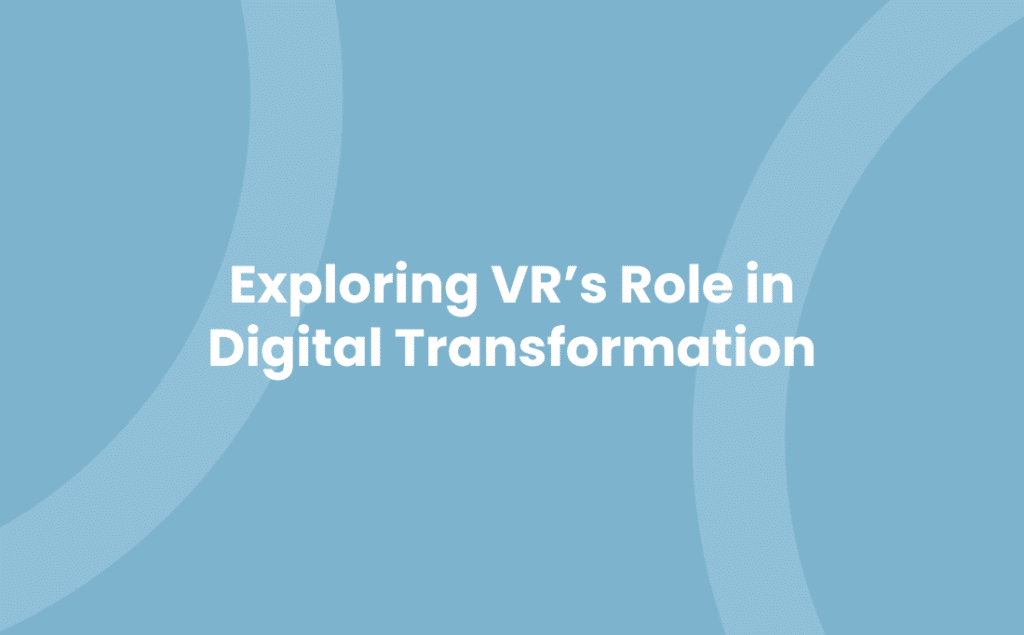Dive into the future as we explore the thrilling intersection of digital transformation and virtual reality (VR) applications. As you navigate the digital age, it’s essential to keep up with the latest trends and technologies. VR isn’t just about gaming anymore; it’s reshaping the way we do business, learn, and interact with the world around us.
Unravelling the Concept of Digital Transformation
Digital transformation represents the process of assistance and recovery, making organisations reinvent their business models and adapt to the digital age. There’s no defined definition of digital transformation. Rather, it’s a concept that varies from business to business, based on their individual aims and objectives.
Under the umbrella of digital transformation, as a business leader, you may witness the deconstruction of traditional systems and ways of working. Enter modernised business structures, the use of artificial intelligence (AI), machine learning, and of course, virtual reality (VR).
Digital transformation VR applications serve as a clear example of how technology is reshaping our day-to-day business. Being widely used for training and development purposes, VR offers immersive experience which takes out the boundaries of traditional e-learning. According to the PWC’s 2020 report, VR learners are 275% more confident to apply the skills learned after training, demonstrating a clear example on how VR supports businesses in the transitional process.
Virtual Reality in digital transformation is producing game-changing outcomes for customer experience. A Forbes 2020 technology report elucidated how VR’s capabilities offer real-time interactions for customers, thus opening up new avenues for business-customer engagement which traditional channels couldn’t.
As you navigate through the current digital landscape, be prepared to embrace these advances and look for ways to make them work for your business. The upshot? A more streamlined, agile and ultimately more profitable business.
The race is on in the realm of digital transformation. Strategies are constantly evolving, and competition is fierce. Getting up to speed means grasping the concept and understanding where the opportunities lie, especially in relation to VR applications. Modernise or risk being left behind. That’s the reality of today’s fast-paced digital era.
Virtual Reality (VR): Redefining Digital Experiences
Dive into the realm where Virtual Reality (VR) intertwines with digital transformation, creating an immersive dynamic. Virtual Reality isn’t just a figment of science fiction any longer, but a transformative technology with practical applications in the business realm. It redefines customer experiences and modes of workforce training, thereby becoming a crucial gear in the machinery of digital transformation.
VR’s application in this digital facelift offers comprehensive, immersive experiences that engage customers beyond the conventional. For instance, estate agents offer virtual property tours, providing an authentic feel of potential homes, setting their digital services apart. In the automotive industry, prospective customers enjoy a realistic test drive experience from their living rooms, amplifying the digital purchasing journey.
At its core, VR offers an enhanced user engagement model. It superimposes a computer-generated environment over the user’s reality, providing a sense of presence there. This creates immersive experiences that surpass boundaries of traditional digital experiences.
Furthermore, VR exerts a game-changing influence on workforce training and development. Industries dealing in high-risk environments utilise VR training for safety purposes. The use case can be found in the aviation sector for pilot training, in the defence sector for battle simulations, and in the healthcare sector for complex surgical simulations.
Another remarkable aspect of VR in digital transformation is data visualisation. VR delivers data in a more digestible and interactive format. In areas like space exploration or genetic research, VR visualisation simplifies the immense volumes of complex data.
Virtual Reality, in essence, offers businesses an opportunity to view digital transformation through a new lens. It redefines digital experiences, strengthens customer engagement, and enhances workforce training, transforming the digital landscape one industry at a time. Companies that align VR with their digital transformation strategy are better equipped to tackle the challenges of the ever-evolving digital landscape.
Bridging the Gap: Digital Transformation and VR
Synthesising digital transformation and VR provides fascinating insights, showcasing a powerful intersection of technology. Here, we delve into ways that VR integration streamlines digital transformation processes.
VR Empowers Companies in Their Digital Journey
In combining digital transformation and VR, companies gain an advantageous edge. The transition becomes immersive, bridging the gap between physical and virtual. For example, in the training sector, VR enables a real-time, interactive environment. As a result, employees grasp the necessary knowledge more effectively, propelling the transformation journey a step further.
Redefining User Experiences through VR
Virtual Retail showcases how VR enriches customer interactions in our digital era. By merging immersive shopping experiences with the ease of online retail, VR provides a customer-centric approach. Potentially, consumers can navigate through a virtual store, inspecting each product in 3D. Bringing VR into focus, digital transformation clearly promotes enriched, end-to-end customer journeys.
Revamping Traditional Business Processes
Marrying digital transformation and VR unlocks potential in revamping traditional processes. In manufacturing, VR helps with product prototyping, allowing engineers to detect flaws before production. This optimises costs and validates design choices, integral to effective digital transformation.
Facilitating Information Representation
In data visualisation, VR brings transformative changes. Traditional diagrams or graphs limitations hinder understanding. But imagine visualising complex data sets in 3D. VR ensures data interpretation becomes intuitive and engaging, an essential aspect of successful digital transformation.
In sum, VR plays a pivotal role within digital transformation. It’s an innovative catalyst, reshaping user experience, optimising processes, and transforming data visualisation. By merging the digital transformation VR, companies gain an added edge, making strides in the digital landscape.
VR Applications Transforming Industries
The role of VR in digital transformation is both impressive and revolutionary. Businesses unlock immense possibilities by applying this technology, facilitating unprecedented innovations in various sectors. Let’s explore three main areas where VR applications revolutionise industries.
Healthcare: Teaching and Treatment
In the healthcare sector, VR has emerged as a transformative tool, drastically altering traditional methods of treatment and teaching. VR-based medical training applications provide hands-on practice to novice surgeons without risk. It enables them to simulate surgeries, improving their competency before they venture into real operations. In terms of treatment, VR therapy assists patients suffering from post-traumatic stress disorder (PTSD) by exposing them to virtual stressors, helping them overcome their fears in a controlled environment.
Real Estate: Property Viewing
VR is a game-changer in the real estate industry. It serves as an effective & efficient tool for property viewing. With VR applications, potential buyers get the experience of a property walk-through from their comfort zones. It simplifies the decision-making process, cutting down on the logistical hassles of physical visits. Thus, VR serves as a vital part in the digital transformation of the real estate industry.
Education: Interactive Learning
Virtual reality in education has reshaped the conventional learning environment into a stimulating and interactive one. By incorporating VR applications in the curriculum, complex subjects become visually digestible and interaction-oriented for students. It not only increases their interest but also enhances retention of acquired information.
In essence, digital transformation VR acts as a catalyst, impelling industries to evolve with its powerful applications. Industries adapt to this digital shift, experiencing a profound shift in operation, performance, and the user experience. These aforementioned sectors illustrate the influential potential of VR, hinting at the vast scope of its future endeavours. Embracing these changes determines a company’s ability to harbour the benefits of this innovative tool and thrive in the ever-competitive market landscape.
Case Studies of VR Applications in Digital Transformation
Tommy Hilfiger: Redefining Customer Experience
In the fashion industry, notably Tommy Hilfiger, VR acts as a digital trailblazer. When Tommy Hilfiger introduced VR in their stores, buyers experienced a 360-view of their fashion show, thus providing them a first-row experience. The implementation helped transform the traditional shopping experience into an immersive one.
Airbus: Perfecting Manufacturing Processes
Airbus has integrated VR technology to perfect their manufacturing processes. It provides their designers a virtual prototype of the aircraft. They can interact with the components, simulate workflows, thus significantly improving the design before actual manufacturing. It’s a step towards a digitally transformed business model.
Johnson & Johnson: Enhancing Surgery Training
Johnson & Johnson’s VR magic doesn’t lie in product promotion but in medical training. They’ve developed a VR platform offering real-life operating room scenarios, aiding in training surgeons. The technology facilitates safe and efficient learning, underscoring VR’s disruptive potential in healthcare digital transformation.
Volkswagen: Revolutionising Employee Training
The German carmaker, Volkswagen, provides a testament to the use of VR in workforce training. They’ve adopted a digital strategy that blends standard procedures with VR training. Their employees can learn from interactive 3D renderings of their mechanics and assembly line operations, marking a shift in pavrolephony from conventional methods.
These four examples emphasise the potential of VR applications in digital transformation across diverse sectors. From enhancing customer experiences to perfecting manufacturing processes, from medical training to workforce development, VR’s malleability and immersive properties prove instrumental in driving digital growth. Thus, embracing VR could be a transformative step for companies wishing to thrive in this digitally-saturated era.
Barriers and Challenges in Integrating VR with Digital Transformation
VR integration can amplify digital transformation, yet an array of barriers can hinder its implementation. A clear understanding of these challenges paves the way for effective solutions, allowing businesses to tap into VR’s transformative potential.
- Cost Implications Acquiring, implementing, and maintaining VR technology are not inexpensive endeavours. High-end VR equipment, along with suitable software, demand significant upfront investment, a factor that may disincentivise SMEs.
- Technical Know-how Successful integration hinges on technical proficiency. Businesses require skilled personnel conversant with VR technologies, digital transformation VR and their applications. Without this expertise, companies face hurdles in leveraging the benefits of VR.
- User Experience Hardware constraints and limited interface designs may negatively impact user interaction and experience. Problems like motion sickness, fatigue and discomfort from prolonged VR use are common user concerns related to VR.
- Data Security and Privacy Oddly enough, captivating, immersive VR experiences can lead to privacy and security issues. As with all digital technologies, VR faces risks relating to data breaches and privacy invasion.
- Need for Change Management Integrating VR into current business operations demands significant change management. Many employees might resist transitioning to unfamiliar technologies, essentially creating a cultural obstacle to VR integration.
Addressing these challenges is paramount for successful VR implementation in digital transformation. Through balanced investment, focused skill development, improvement of user experience, robust security measures, and strategic change management, your business can turn these barriers into stepping stones towards successful digital transformation with VR.
Future Prospects of VR in Digital Transformation
Embarking on the road leading to the future, the use of virtual reality (VR) in digital transformation, is set to experience unprecedented growth. This phenomenal integration is anticipated to open new doors, driving innovation, operational efficiency, and improved user experiences.
Revolutionising customer interaction stands as a pivotal aspect in the rapidly evolving landscape of VR applications. No longer confined to the gaming arena, VR now bolsters immersive, interactive spaces for user engagement. Picture this: A retail customer, miles away from your brick-and-mortar shop, peruses your inventory in a near to real-life, 3D virtual setting. That’s the revolution digital transformation VR brings to the table.
From a more operational perspective, VR holds the power of disrupting the training and development domain across industries. Engaging, interactive, VR-based training modules aimed at enhancing employee skills and performance are no longer an elusive concept. This has proven especially beneficial in high-risk sectors where real-life training can pose significant safety concerns.
Speaking of the healthcare sector, VR could act as the cornerstone of digital transformation, pushing the traditional boundaries of patient care. Patients could undergo psychological therapy sessions in controlled, custom-built VR environments, thereby speeding up recovery times.
Looking ahead, one can envision a realistic virtual environment where architects and engineers manipulate digital prototypes, saving time, cost, and labour. The real estate industry stands to gain immensely from such VR-led transformations, with virtual tours becoming the new norm for property showcasing.
What about data visualisation? In an era where businesses grapple with big data, VR could transmute complex data sets into interactive, 3D visual formats. It simplifies data analysis, aids decision making and, ultimately, drives business growth.
Each of these scenarios underlines the endless potential of VR in digital transformation. However, they also hint at the necessity of surmounting related challenges, be it cost, technical skills, UX, security, or change management. With continued investment and appropriate security measures, it’s plausible to foresee a future where VR becomes the heart of digital transformation across multiple sectors.
With the progression of this successful integration, be prepared for a future reshaped by VR’s influence on digital transformation. The journey continues and offers exciting prospects that are set to redefine the next era of digital evolution.
Conclusion
Embracing VR’s role in digital transformation isn’t just about adopting new tech; it’s about overcoming challenges and investing in the right security measures. By doing so, you’re setting the stage for a future where VR isn’t just an add-on, but a defining force in digital evolution. Whether it’s revolutionising customer interactions, transforming training, or reshaping sectors like healthcare and architecture, VR’s potential is vast and undeniable. So, it’s time to look beyond the barriers and see VR for what it truly is: a catalyst for digital transformation. Remember, it’s not just about riding the wave of digital change; it’s about steering it in the right direction. And with VR, you’re not just on the right path, you’re on the path to the future.


